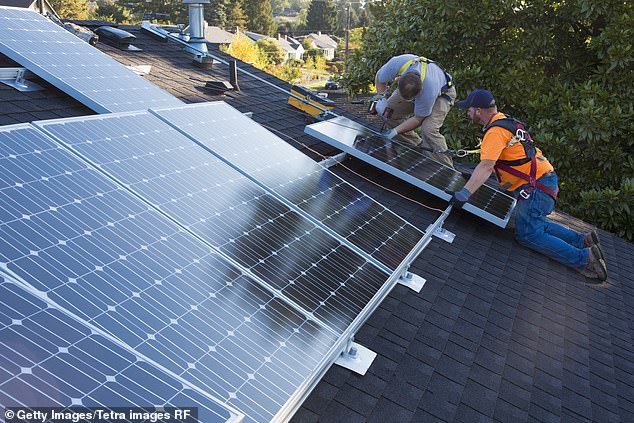With a home battery you can save up to 85 percent on your energy bill, but can you also have a ‘zero bill’ house?
According to The Energy Savings Trust, homeowners can save up to £796 a year on their energy bills by installing a battery storage system in their home.
For a three-bedroom home with average energy prices, this can amount to as much as 85 percent of energy costs.
While solar panels alone can save the average household around £310 a year, battery storage systems make it possible to store the energy transferred from sunlight for use at night.
Money Savings: Although battery storage systems can have a significant upfront cost, homeowners can realize huge savings on their electric bills
Using solar panels alone will save homeowners about 30 percent of their energy bills, according to Mark Millar, CEO of battery manufacturer Puredrive Energy.
He said: ‘The average house (with solar panels) uses 10 kilowatt hours of energy per day, except that only 30 percent of the energy is absorbed into the house because we generate energy during the day but use energy in the evening and morning.
‘The remaining 70 percent of the energy goes into the electricity grid, so the homeowner sees no benefit in that.’
According to Millar, adding a battery system allows this otherwise wasted energy to be stored and used in the evening and potentially the next morning, delivering savings of up to 60 percent.
While around 1.4 million UK households have solar panels, around 4.9 per cent of the population, only 43 per cent of those with solar panels, or 602,000, also have a home battery.
However, the most modern systems can use variable rates to store energy when it is cheap, for use during periods when it is more expensive. It is this, Millar said, that can deliver savings of up to 85 percent.
“It’s a big change that’s really happened in the last two years,” Millar said. ‘Some energy companies offer flexible tariffs where the energy price changes every hour or so… if you have a smart battery it knows when the rates are cheap and provides energy when the rates are high.’
Puredrive produces the new Dura 5 home battery from Duracell Energy. The product competes with the likes of Tesla and Sunsynk, both of which also offer home storage systems.
Installing a battery storage system in your home can put you on the path to lowering your bills, but according to Puredrive, it can also help you stop paying energy bills altogether.
By combining solar panels, a home battery and an air source heat pump, homeowners can create a system that requires nothing from the grid, the company said.
“Zero bills,” Millar said, can currently be achieved by people with brand new homes who combine these technologies with selling their excess energy back to the grid during peak times.

Complete system: Installing solar panels in addition to a home battery and heat pump will have significantly higher costs than installations with batteries only
Homeowners can use the government’s Smart Export Guarantee to sell their excess energy. The SEG tariff has replaced the Feed-in tariff scheme, which closed in 2019.
“District grid operators will give you money if you support the grid,” he told “Money.” ‘If you watch Manchester United versus Liverpool, the boilers come on at half-time and there is an increase in usage. You get paid money to be able to support the grid, and when you combine that with the technology in your home, the whole goal is to get to net zero.”
How much can this technology save you?
The cost of installing a solar system can vary greatly depending on the products you want to install and the type of home in which you want to do the installation.
Typically, installing a full system consisting of an air source heat pump, solar panels and a home battery can set homeowners back £20,000 according to data from EcoQuoteToday, or £12,500 with the government’s £7,500 Boiler Upgrade Scheme rebate.
This figure, according to Millar, is largely made up of installation costs, meaning that if the technology is installed during the construction process, it could be much lower.
He said: ‘If you install these when you build a house, you already have scaffolding on which you can put the roof on, so that solar panels can go on straight away. The cables can also be added during the construction process.’
‘We’re talking £4,000 for each new house. If you were to install this technology on an existing home, an installer would charge around £12,000.”
Installations that run solely on batteries are increasing
For many, the cost of installing batteries, heat pumps and solar panels can be far beyond their home improvement budget.
However, Millar says battery-only installations are becoming increasingly popular because they have a simple installation process that can dramatically reduce costs compared to a full installation.
“The payback period is much faster,” he said. ‘If you charge the battery when it is cheap, you pay 8 cents instead of 30 cents per kilowatt hour, then you save considerably.
‘A few times a day the energy only costs 5 cents, your batteries can be charged during that time and then you can use the energy all day long.’
To install a battery alone, homeowners can expect to pay between £4,000 and £5,000.
However, Millar points out that battery-only installations cannot make homeowners independent of the electricity grid. He said, ‘That’s the difference you know from a philosophical perspective. It will be cheaper now, but will it be cheaper next year or the year after? That depends on the energy supplier.’
Some links in this article may be affiliate links. If you click on it, we may earn a small commission. That helps us fund This Is Money and keep it free to use. We do not write articles to promote products. We do not allow a commercial relationship to compromise our editorial independence.
